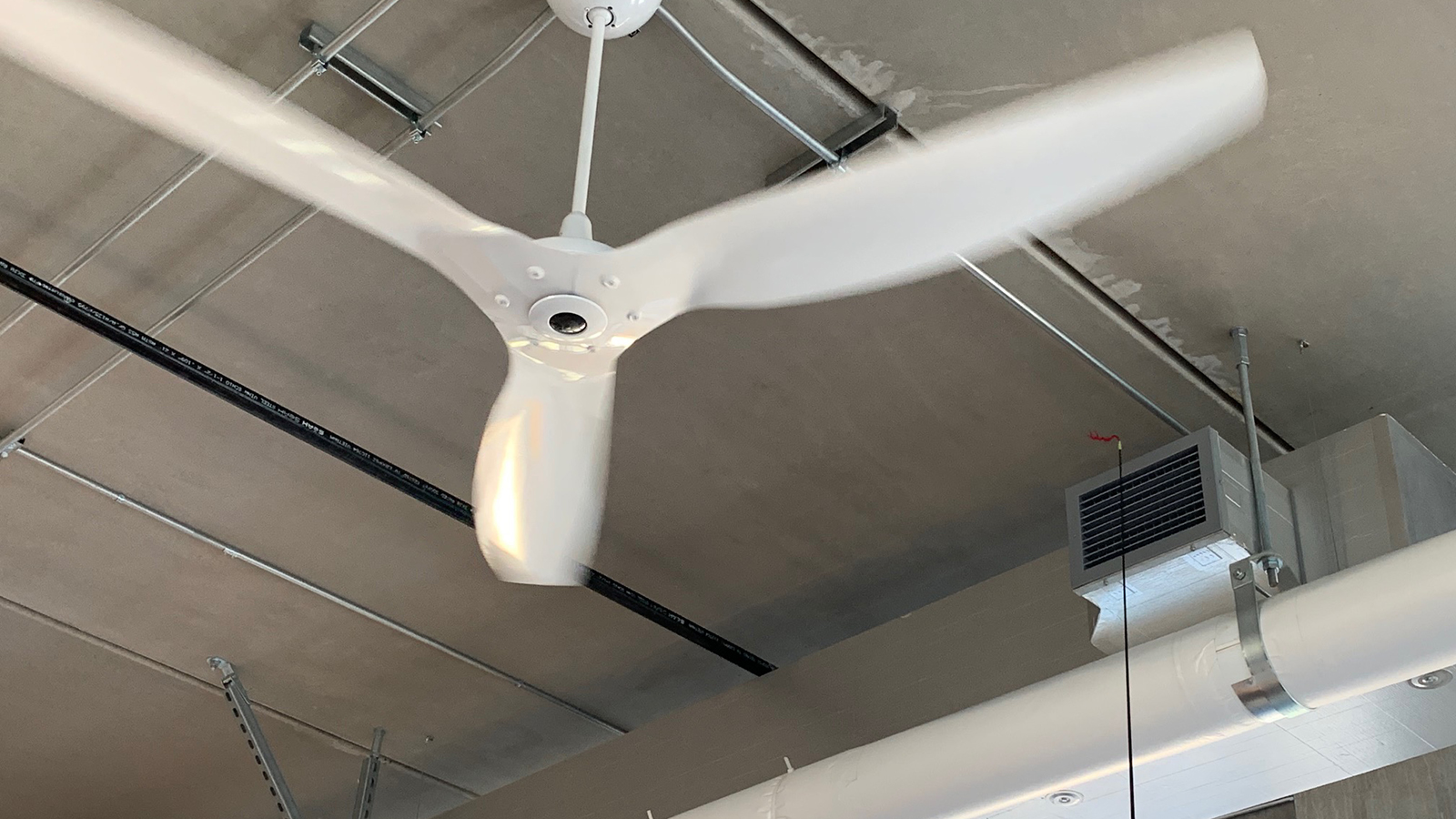An innovative design approach that takes advantage of fans for cooling and mixing supply air.
Status: Current
Funding Sources: CBE membership funds In-kind support from Western Allied Mechanical
Project Objective
This project is quantifying the thermal comfort and ventilation effectiveness in buildings using a new HVAC concept that integrates ceiling fans with air conditioning. An additional goal is to compare the construction costs of this system in commercial office buildings, at zone- and whole-building scales, against conventional HVAC designs.
Project Results
Laboratory studies showed that ceiling fans mix unducted supply air very well, providing uniform room temperatures and sufficient air ventilation effectiveness within the occupied zone. These studies also showed thermal comfort equal or better than that with traditional ducted overhead diffusers. In addition, a detailed comparison of a CFIAC design in an actual open plan office showed that the new approach reduced the number of VAV zones from 14 to 4 (or even two), with a design that included 12 ceiling fans for air mixing. Overall, the net cost reduction in ductwork and air handling equipment was between 30 and 50 percent.
Laboratory studies found that CFIAC provided thermal comfort equal or better than traditional ducted overhead diffusers. A detailed cost analysis found that cost reduction in ductwork and air handling equipment of between 30 and 50 percent.
Significance to Industry
Conventional air conditioned buildings are currently designed to maintain temperatures that are comfortable in still air. Under cooling modes it is a challenge for building designers and operators to maintain still air in a room. The relatively dense cooled supply air tends to fall (‘dump’) into the occupied space, and diffusers need to be spaced closely to provide uniform coverage, requiring significant terminal ductwork and substantial numbers of diffusers. These systems are often operated at relatively high volumes of supply air to help mixing, a practice that limits energy efficiency at partial loads and also the ability to control space temperatures. For these and other reasons, the conventional approach of cooling using cool temperatures with still air is highly energy intensive.
Ceiling-fan integrated air conditioning, or CFIAC, replaces most of a zone’s terminal supply ducts and diffusers with high level side-wall nozzles or vents, jetting supply air toward ceiling fans that serve to mix and distribute it within the room. By using air movement as part of a thermal comfort strategy, this approach can also operate over a wider range of temperatures than conventional HVAC systems, and notably with higher thermostat temperatures during cooling mode. Both supply-fan energy and first costs are reduced. It may also improve both comfort and ventilation effectiveness compared to current practice.
Research Approach
This work has been performed as a series of tests including laboratory tests focusing on physical measurements, followed by tests with human subjects, and finally a comparative cost study on an existing project in collaboration with professional highly experienced HVAC engineers and subcontractors.
First, we examined air speed and temperature distribution by performing experiments in CBE’s environmental test chamber. The supply air emerged from a high sidewall vent directed toward a ceiling fan in two conditions: with a fan on the jet centerline, and a fan located to the side of the jet. The results show that temperatures are well mixed and uniform across the room for all of the fan-on configurations, for fans both within or out of the supply vent centerline. We also evaluated ventilation effectiveness of the system by measuring CO2 delay to calculate the age of air. The age of air was reduced 20 to 40 percent below that of conventional operation for all fan-on conditions.
Second, we performed human subject tests to evaluate comfort at various locations in the chamber (directly under the fan or away from it), various fan settings (various speeds, and directions both upward and downward), and compared these with a conventional design with overhead diffusers at a lower ambient temperature. The results show that for all tested configurations, comfort was equal to or better than the overhead control condition. We also found that the subjects’ acceptance of air movement under downward fans was considerably better than what would be predicted by current comfort standards. Consistent with previous research by CBE and others, we found that many people prefer some air movement when exposed to neutral temperature still-air conditions.
Finally, we performed cost analyses of the CFIAC strategy compared to conventional designs at the room and building levels. We collaborated with CBE partners Western Allied Mechanical using as a case study an office building of 172,000 ft2 that was under construction at the time of the study. This team developed alternate designs for a typical open-plan office floor, using ceiling fans and eliminating zone ductwork and diffusers. The team estimated the costs for both the traditional diffuser and the ceiling fan layout, with two alternates for the number of zones.
Publications and Reports
Chen, W., H. Zhang, E. Arens, M. Luo, Z. Wang, L. Jin, J. Liu, F. Bauman, and P. Raftery. 2020. Ceiling-fan-integrated air conditioning: Airflow and temperature characteristics of a sidewall-supply jet interacting with a ceiling fan. Building and Environment, Volume 171. March.
Journal link: https://doi.org/10.1016/j.buildenv.2020.106660
Open source link: https://escholarship.org/uc/item/8cj7n6ps

